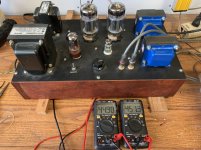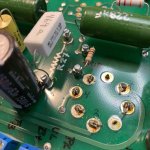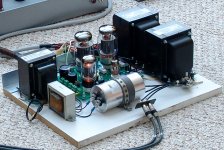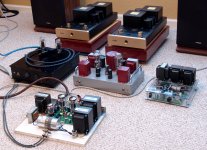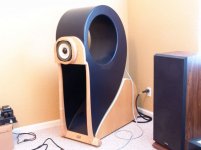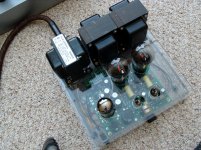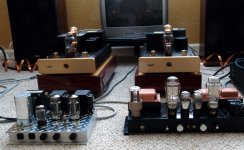After 20-30 hours of operation, the EH KT88s I’ve been auditioning in my SSE amps decided to get cranky, i.e. OSCILLATE.
Don’t know if it was a change in the tube or a change in environmental noise, but it definitely was the KT88s; same VFO (controlled by 100K volume pot) with the 12AT7 pulled).
These amps were build 8-10 years ago, so the grid stopper resistors were on the TOP side with the sockets (not my current practice), so out came both boards to see how much grid stopper I need.
I know that George likes him some crazy-low grid stoppers, but then he’s always building amps that could do double duty as AM band transmitters, so I take that with a grain of salt.
(A) installed single screw terminals on the backside of the board to allow changing the grid stopper resistor
(B) slapped some 1N4007s on the high tension leads (the “DYNACO” mod) so I can comfortably use 5AR4/GZ34 rectifiers; I told you, these are OLD boards.
If you’re contemplating an SSE amp, I would tell you to use these single-point screw terminals for (a) power tube cathode resistors (b) power tube grid stoppers and maybe (c) coupling cap and (d) C1, if you think you can see the need for changing B+ sometime...
I have 1K stoppers in there now, which has eliminated about 80-90% of the oscillation (judging by the sweep of the vol pot). Looks like ~1500 or 2k ohms might be called-for. Would like to use as low a value as possible, but trying to avoid dragging-out the scope and dummy load; it’s the shop amp after all.
Has anybody else seen this with the EH KT88s in the SSE amp?
I’m a little surprised, but I do remember thinking that George’s stoppers were a lot lower resistance that the 1K I was used-to at the time....
Don’t know if it was a change in the tube or a change in environmental noise, but it definitely was the KT88s; same VFO (controlled by 100K volume pot) with the 12AT7 pulled).
These amps were build 8-10 years ago, so the grid stopper resistors were on the TOP side with the sockets (not my current practice), so out came both boards to see how much grid stopper I need.
I know that George likes him some crazy-low grid stoppers, but then he’s always building amps that could do double duty as AM band transmitters, so I take that with a grain of salt.
(A) installed single screw terminals on the backside of the board to allow changing the grid stopper resistor
(B) slapped some 1N4007s on the high tension leads (the “DYNACO” mod) so I can comfortably use 5AR4/GZ34 rectifiers; I told you, these are OLD boards.
If you’re contemplating an SSE amp, I would tell you to use these single-point screw terminals for (a) power tube cathode resistors (b) power tube grid stoppers and maybe (c) coupling cap and (d) C1, if you think you can see the need for changing B+ sometime...
I have 1K stoppers in there now, which has eliminated about 80-90% of the oscillation (judging by the sweep of the vol pot). Looks like ~1500 or 2k ohms might be called-for. Would like to use as low a value as possible, but trying to avoid dragging-out the scope and dummy load; it’s the shop amp after all.
Has anybody else seen this with the EH KT88s in the SSE amp?
I’m a little surprised, but I do remember thinking that George’s stoppers were a lot lower resistance that the 1K I was used-to at the time....
Attachments
UPDATE:
Changing the grid resistor value MOVED the oscillation around on the volume "dial", but did not eliminate it. Has to be the (undamped) local feed-back (i.e. no resistor in the circuit.)
Unfortunately, I haven't installed feedback SWITCHES on my SSEs (I've always liked the local feedback with lower-powered tubes), so had to do a little RE-WIRING.
That worked. Clear as a bell, no oscillation anywhere. Reverted to 1500 ohm grid stoppers, as I had that value in carbon comp resistors.
HOWEVER, with my high efficiency speakers (about 97 dB/W) the music is a little too "forward", as if I needed to adjust the L-pads on the speakers. Unfortunately, I DON'T HAVE L-pads on the shop speakers, so I'd have to get up on a ladder and install them (and then go up & down the ladder to adjust them.
Couldn't I just add a series resistor (say 1K to start) in the feedback circuit?
Say, between the 8 ohm lead and the feed-back terminal?
Changing the grid resistor value MOVED the oscillation around on the volume "dial", but did not eliminate it. Has to be the (undamped) local feed-back (i.e. no resistor in the circuit.)
Unfortunately, I haven't installed feedback SWITCHES on my SSEs (I've always liked the local feedback with lower-powered tubes), so had to do a little RE-WIRING.
That worked. Clear as a bell, no oscillation anywhere. Reverted to 1500 ohm grid stoppers, as I had that value in carbon comp resistors.
HOWEVER, with my high efficiency speakers (about 97 dB/W) the music is a little too "forward", as if I needed to adjust the L-pads on the speakers. Unfortunately, I DON'T HAVE L-pads on the shop speakers, so I'd have to get up on a ladder and install them (and then go up & down the ladder to adjust them.
Couldn't I just add a series resistor (say 1K to start) in the feedback circuit?
Say, between the 8 ohm lead and the feed-back terminal?
Last edited:
SSE Damped Feedback Circuit; that worked
I put a 1K (carbon film) resistor in series with the power tube cathode cap, as a means of "damping" the feedback which was causing the KT88 oscillation.
That seems like it was a pretty good guess; the "forwardness" in the upper registers is gone, and no oscillation.
Unfortunately, I have no idea how to calculate how much "damping" is represented by 1000 ohms in this LOCAL feedback circuit. I suppose that ought to be measured in decibels, eh?
I suppose I could try substituting resistor values 'til I find the edge of parasitic oscillation, then call it good. Maybe I'll pull a couple of leads out and do that...
I put a 1K (carbon film) resistor in series with the power tube cathode cap, as a means of "damping" the feedback which was causing the KT88 oscillation.
That seems like it was a pretty good guess; the "forwardness" in the upper registers is gone, and no oscillation.
Unfortunately, I have no idea how to calculate how much "damping" is represented by 1000 ohms in this LOCAL feedback circuit. I suppose that ought to be measured in decibels, eh?
I suppose I could try substituting resistor values 'til I find the edge of parasitic oscillation, then call it good. Maybe I'll pull a couple of leads out and do that...
Last edited:
100 ohms still had a tiny bit of audible oscillation at highest volume setting.
270 ohm (next largest carbon comp I have) seems to have NO audible oscillations.
Probably should hook-up a scope to see what's really there...
Note that I REALLY like the sound of George's local feedback on the SSE, otherwise I'd just live without it.
Alternately, I could try triode operation, but I really like the sound of the ultralinear circuit, too, so here we are.
270 ohm (next largest carbon comp I have) seems to have NO audible oscillations.
Probably should hook-up a scope to see what's really there...
Note that I REALLY like the sound of George's local feedback on the SSE, otherwise I'd just live without it.
Alternately, I could try triode operation, but I really like the sound of the ultralinear circuit, too, so here we are.
Last edited:
Question: should I consider a voltage divider for the dampened feedback on the SSE?
That is:
Resistor from ground to cathode cap
Resistor from cathode cap to 8 ohm tap
Alternately, put the cathode cap on the wiper of a small trimmer pot.
At one end, the cathode cap is grounded and by-passes Rk.
At the other end, the cathode cap is ~isolated from ground and connected to feedback.
That is:
Resistor from ground to cathode cap
Resistor from cathode cap to 8 ohm tap
Alternately, put the cathode cap on the wiper of a small trimmer pot.
At one end, the cathode cap is grounded and by-passes Rk.
At the other end, the cathode cap is ~isolated from ground and connected to feedback.
... it definitely was the KT88s; same VFO (controlled by 100K volume pot) with the 12AT7 pulled). ...
That's certainly an odd feedback path, through the volume control and an EMPTY tube socket ...
Are congratulations in order? I don't recall anyone making a power tube oscillate in an SSE. I do recall one person making the 12AT7 oscillate.
I don't even have grid suppressors in my caged SSE or the DHT SSE. I made the front end on my TSE randomly oscillate at audio from time to time; I was never really successful at completely eradicating it. It lived a really hard life. My input wiring and grounding was probably not up to snuff. When I modified it to run 801A's, I was sure I got a mild RF bite from the thing.
(1) the electrical noise in the shop is pretty severe; the amp sits less than a meter from the entrance panel, wired by an alcoholic electrician. OTOH I've gotten an RF bite from a 20M Inverted Vee antenna, but never from an AUDIO amp..
(2) lots of "antennae" under the chassis, what with all the single-point terminal blocks and unclipped leads, since this is my "test bed" amp. For example, none of the transformer or choke leads are cut to length, but twisted and coiled (although not anywhere near the 3 twists/inch standard)
(3) running just under 40 W dissipation in ultraLinear. Didn't try triode mode, but my guess is that would have fixed it. Frankly, I don't see many folks running SE amps in ultralinear, let alone KT88s; I think folks associate it with Dynaco P-P amps...
(4) still using the cathode feedback, although I've got the feedback "damping resistor" down to about 125 ohms (2x 270 ohm carbon comp in parallel). Gonna fetch some more carbon comps and see if I can squeeze that damping number down some more, then put the scope on it with a 1khz square wave and see what we've got.
Been testing everything from Jimi (@11) to Girl w/ Guitar. Ears Only, this is the best pentode SE amp I've heard. My very first tube amp (last century) was a JE Labs EL34 with 6SL7 driver, IIRC, so I tried just about everything from EL34 to 6AV5s...
Clarity on par with the Quad 303, and bass is very close.
For the WAF version, I may spring for the the 10# Edcors (CXSE) and a 220mA Edcor PST that's in stock.
"Let's Talk Dirty in Hawaiian" on right now. Prine is in the House, RIP.
(2) lots of "antennae" under the chassis, what with all the single-point terminal blocks and unclipped leads, since this is my "test bed" amp. For example, none of the transformer or choke leads are cut to length, but twisted and coiled (although not anywhere near the 3 twists/inch standard)
(3) running just under 40 W dissipation in ultraLinear. Didn't try triode mode, but my guess is that would have fixed it. Frankly, I don't see many folks running SE amps in ultralinear, let alone KT88s; I think folks associate it with Dynaco P-P amps...
(4) still using the cathode feedback, although I've got the feedback "damping resistor" down to about 125 ohms (2x 270 ohm carbon comp in parallel). Gonna fetch some more carbon comps and see if I can squeeze that damping number down some more, then put the scope on it with a 1khz square wave and see what we've got.
Been testing everything from Jimi (@11) to Girl w/ Guitar. Ears Only, this is the best pentode SE amp I've heard. My very first tube amp (last century) was a JE Labs EL34 with 6SL7 driver, IIRC, so I tried just about everything from EL34 to 6AV5s...
Clarity on par with the Quad 303, and bass is very close.
For the WAF version, I may spring for the the 10# Edcors (CXSE) and a 220mA Edcor PST that's in stock.
"Let's Talk Dirty in Hawaiian" on right now. Prine is in the House, RIP.
For much of it's first 2 or 3 years my big white board SSE ran EH KT88's in UL with the cathode feedback turned on. That was the best combo for loud stuff with big bass (DSOTM) through 15 inch speakers. I never saw any instability, but every build is different, especially the choice of OPT. I ran both the Hammond 1628SEA and the Edcor CSE's without issue.
I spent about 2 days chasing oscillation in a test board amp using UD boards with EH KT88's. It got better, then got worse, but never went completely away no matter what I did......until I turned off all the lights to check for glowing screen grids.
The "oscillation" was coming from the overhead Walmart LED shop light, not the amp.
Note that there is no reason that UL can't be used with the UD board. UL is generally not compatible with TV sweep tubes due to their low screen grid voltage rating. You mentioned 30 to 40 watts, and I was getting 75 watts in triode with KT88's, so triode would be my first choice, but UL should work fine with KT88's.
Pictures:
The "white board amp" and the "plastic TSE" go to play with the big boys (late 2006).
Last picture taken a year later:
The SSE gets some clothes.
I spent about 2 days chasing oscillation in a test board amp using UD boards with EH KT88's. It got better, then got worse, but never went completely away no matter what I did......until I turned off all the lights to check for glowing screen grids.
The "oscillation" was coming from the overhead Walmart LED shop light, not the amp.
Note that there is no reason that UL can't be used with the UD board. UL is generally not compatible with TV sweep tubes due to their low screen grid voltage rating. You mentioned 30 to 40 watts, and I was getting 75 watts in triode with KT88's, so triode would be my first choice, but UL should work fine with KT88's.
Pictures:
The "white board amp" and the "plastic TSE" go to play with the big boys (late 2006).
Last picture taken a year later:
The SSE gets some clothes.
Attachments
My Harbor Freight magnifier light spews noise at 30khz when its gets near a scope probe. Watch out for those switching ballasts.
Heck, I think my Harbor Freight STORAGE BOXES spew HF noise.
Finally got the KT88 SSE settled-down.
(a) 1.5K grid stoppers. In retrospect, not sure they are doing anything, but can't hurt.
(b) While I was under the chassis, permanently added 1N4007s in series with the HV leads.
(c) CL-90 for the CT should have been here already from Mouser, but their 2-day delivery to Houston has turned to 5-6 days lately.
(d) tinkered with the feedback "damper" resistor; 72 ohms left a little oscillation from ONE KT-88 (switched sockets to be sure), but 100 ohms seemed to work well.
Used antique Allen-Bradley carbon composition resistors, gauged within an ohm of each other. Probably saturated from our humidity, but should be fine in this low voltage application. (Mouser delivered a bunch of Carbon Comps the other day in a sealed ANTI-STATIC bag, with a warning sticker about HUMIDITY. Never seen that before.)
When the KT-88s aren't SQUALLING, they do sound terrific. Running about 90mA Ik, 35W dissipation, and the little Allied 6K7VG (150 mA rating) is quite warm (and the B+ does drop gradually over a 12 hour shop day) but so far so good.
Gotta spend a few days working on the Rockport TX bungalow, so I'll scope it when I get back...
Finally got the KT88 SSE settled-down.
(a) 1.5K grid stoppers. In retrospect, not sure they are doing anything, but can't hurt.
(b) While I was under the chassis, permanently added 1N4007s in series with the HV leads.
(c) CL-90 for the CT should have been here already from Mouser, but their 2-day delivery to Houston has turned to 5-6 days lately.
(d) tinkered with the feedback "damper" resistor; 72 ohms left a little oscillation from ONE KT-88 (switched sockets to be sure), but 100 ohms seemed to work well.
Used antique Allen-Bradley carbon composition resistors, gauged within an ohm of each other. Probably saturated from our humidity, but should be fine in this low voltage application. (Mouser delivered a bunch of Carbon Comps the other day in a sealed ANTI-STATIC bag, with a warning sticker about HUMIDITY. Never seen that before.)
When the KT-88s aren't SQUALLING, they do sound terrific. Running about 90mA Ik, 35W dissipation, and the little Allied 6K7VG (150 mA rating) is quite warm (and the B+ does drop gradually over a 12 hour shop day) but so far so good.
Gotta spend a few days working on the Rockport TX bungalow, so I'll scope it when I get back...
- Home
- More Vendors...
- Tubelab
- Super Regenerative KT88s -or- Come-In Rangoon
